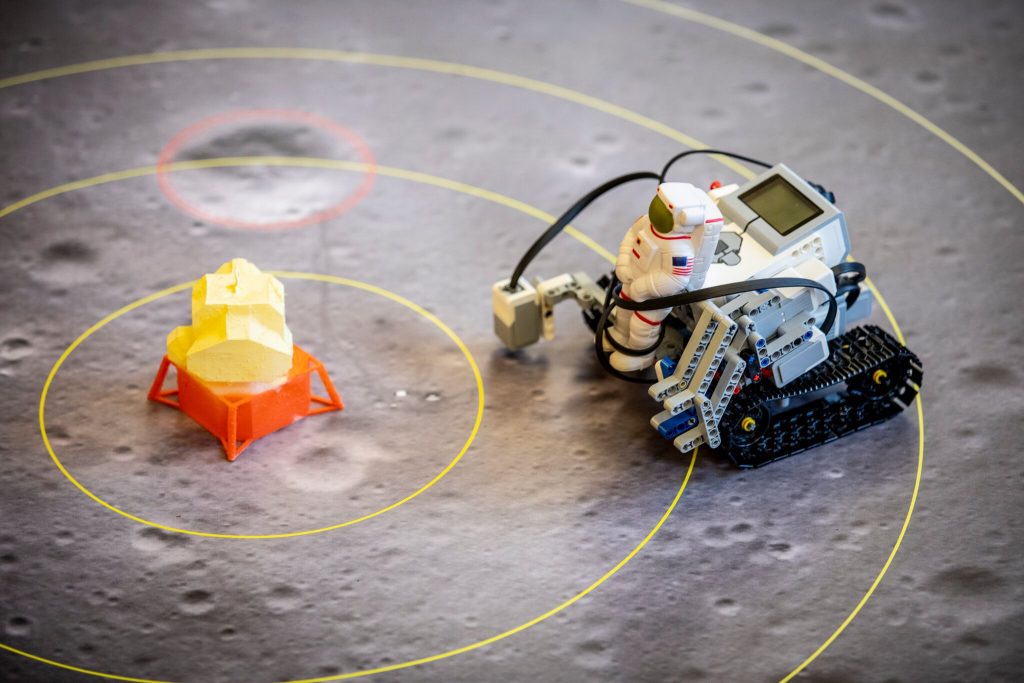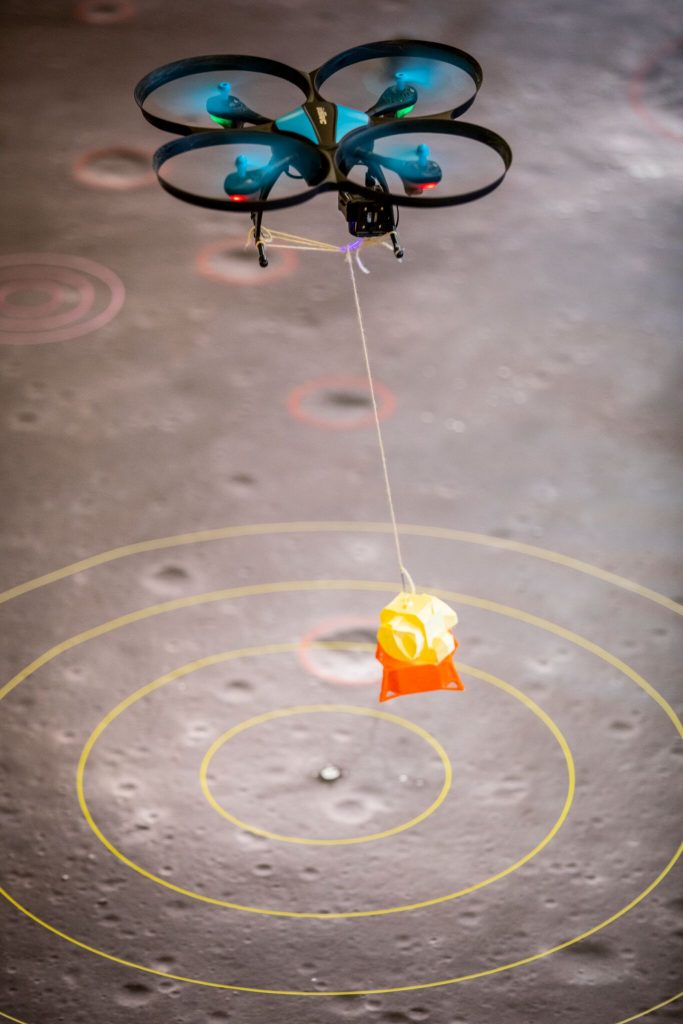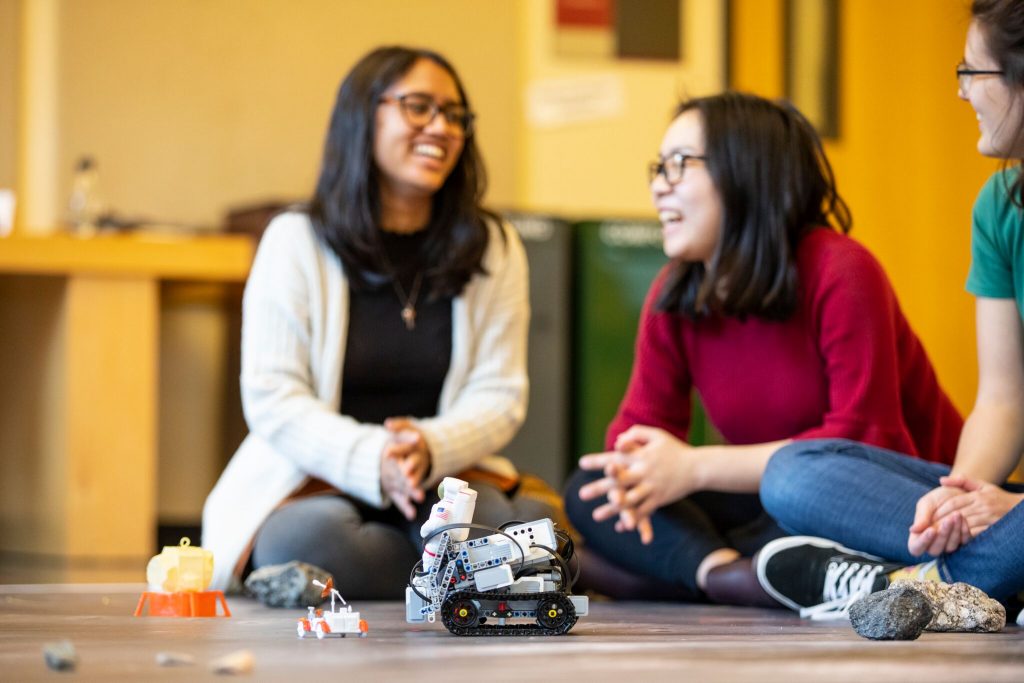UW-based group launches national challenge to recreate first moon landing — with drones and Lego robots

A Lego Mindstorms robot, with a plastic astronaut strapped to the front, approaches the lunar lander. Student teams will program the robot to explore the moon’s surface. Dennis Wise/University of Washington
By Hannah Hickey
UW News
On July 20, 1969, the Apollo 11 mission landed the first two people on the surface of the moon. NASA astronaut Neil Armstrong took the first steps and famously proclaimed: “One small step for man, one giant leap for mankind.”
This July will mark the 50th anniversary of that landmark event. The University of Washington’s Northwest Earth and Space Sciences Pipeline is calling on the next generation of astronauts and aeronautical engineers to recreate the historic event using modern technology.

A flying drone carries a lunar lander above a map of the moon’s surface. The landing spot is the actual site of the Apollo 11 landing. Other craters that teams will explore are circled in red. Dennis Wise/University of Washington
At a kickoff event Jan. 30 in Kent, Washington, the organizers will officially open the Apollo 50 Next Giant Leap Student Challenge, known for short as the ANGLeS Challenge, in collaboration with NASA’s Science Mission Directorate.
“This is a truly interdisciplinary challenge, involving computer programming, robotics, remote sensing and design,” said Robert Winglee, director of the Northwest Earth and Space Sciences Pipeline and a UW professor of Earth and space sciences. “We’re calling it the ‘next giant leap.’”
Teams of students from fifth to 12th grades are invited to participate. Each team will build a replica of the lunar lander and use a remote-controlled drone to land it on an 8-by-10-foot map of the moon’s surface. Students will modify and program a Lego Mindstorms EV3 robot to then explore the lunar surface and bring back a rock sample.
High school students will also use the drone to retrieve the team’s lunar module and bring it back to the starting line.
As in a real-life expedition, teams will also create a mission patch, design uniforms, do event outreach and leave a “culturally significant artifact” on the lunar surface.
Organizers emphasize that it’s a challenge, not a contest. Teams will be judged on multiple criteria and can earn various prizes. No experience is required; registration opens Feb. 1.

These University of Washington students demonstrate the challenge involving a lunar lander (left, orange) a Lego Mindstorms robot (center) and rock samples (right). Dennis Wise/University of Washington
The challenge has no entry fee. A $500 kit contains subsidized equipment including the drone and Lego Mindstorms parts, and loaner equipment will be available to schools that qualify. Accommodation at the UW campus will be covered for teams at schools with more than 50 percent subsidized lunches. The organizers will also help all teams with fundraising, and can provide drone and robotics training on request.
“An important aspect of the project is to provide access to NASA science and technology for many of the underserved and underrepresented communities across the U.S.,” Winglee said.
Teams must include one adult to act as the coach, and a five-member “flight crew” all under the age of 18 who will be on the challenge field to pilot the drone, operate the robot, identify rock samples and guide the pilot. Other members of the mixed-grade teams will help with building equipment, designing logos and other off-the-field tasks.
The Northwest challenge will be held in July in Seattle and is open to teams from schools or recognized informal education programs in Washington. Twelve other NASA regional hubs will also host events the week of July 15-20. The winning team from each location will win a trip in early August to visit NASA’s Johnson Space Center in Houston.
The initial sponsors of the national challenge are drone maker Force1, NASA, the Museum of Flight, Pacific Science Center and the City of Kent. Organizers are seeking more event sponsors, and volunteers to help advise teams and host the challenges.
The UW-based Northwest Earth and Space Sciences Pipeline consortium was created in 2016 with a $10 million cooperative agreement that established a “NASA hub” in the Pacific Northwest. The group conducts teacher trainings, especially in underrepresented communities; its past events include a NASA Pow Wow in Ellensburg and a NASA Fiesta in Seattle.
“Smaller-scale, related STEM efforts in recent years have shown that student participants have increasing interest and skill in doing STEM activities,” Winglee said. “The Apollo effort seeks to expand this effort on a national scale.”
###
More information is at https://nwessp.org/apollo50/. The challenge email is apollo50@uw.edu
Members of the media can contact communications officer Chris Wallish at 206-221-7743 or cwallish@uw.edu.
Originally posted at UW News.